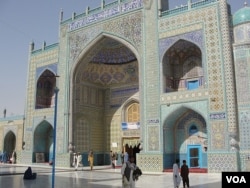The new year in Afghanistan is called Nawroz (sometimes spelled Nowruz or Nawruz in English). The first day of the Afghan month Hamal, which falls on the 21st of March, was the first day of the new year in Afghanistan and some other countries.
This day is considered one of the biggest holidays of the year. People start getting ready for Nawroz a month before and celebrate the actual day following the old Afghan traditions.
One of the biggest traditions for Afghans on Nawroz is to wear green clothes and to cook green things. The idea is to give a new start to their lives, the same as the growth of the green plants in the spring, so they will be green, happy and fresh until the end of the year. The word green in the Dari language is "sabz." Therefore, Afghans prepare seven dishes that start with the letter “S.”
One of the dishes that start with the green (sabz) letter is called Samanak. This is a special dish that takes at least two weeks to get ready to be cooked. The wheat used to make Samanak is kept to grow tall, and then it is cooked. Samanak is usually cooked on Nawroz or few days before, and women sometimes throw a party for it. While the mothers cook Samanak through the whole night, their daughters dance and sing songs.
Here's an old video showing the Samanak ceremony:
In this video you can see some of the other dishes that are cooked for a Nawroz party. Samanak is the one looking like the tall, green grass and is not cooked yet. One of the other dishes on the table is Haft Mewa, which is the bowl full of dry fruits. Afghans buy various dry fruits such as pistachios, raisins, walnuts, dried apricots and almonds to make it, and it is eaten as a snack on Nawroz. Jelabi is the yellow round looking dish. They are sweet and very delicious.
Another tradition is that the night before Nawroz, Afghan girls make Henna tattoos on each others' hands. They make the tattoos before going to bed and let it set until the morning so that it looks really red.
Some families in Afghanistan travel to Mazar-i Sharif, which is one of the provinces of Afghanistan, for the holiday. In Mazar-i Sharif, Nawroz is celebrated in a very special way because of the shrine of “Saint Ali,” who is the cousin and the son-in-law of the Prophet Mohammad (peace be upon him). People go to the shrine and hang out for many hours, and it is also a good place to pray for having a great year ahead.
When Nawroz comes, Afghans celebrate the New Year and look towards the upcoming future. They welcome the New Year with cooking different spring foods. They forget about the sad things that have happened in the previous year and start new friendships.
As a student in the U.S., it could be hard to continue celebrating Nawroz especially in a boarding school. While I have been living in the U.S. for almost three years, I have tried my best to celebrate Nawroz as my family does at home.
During the past two years, I have mostly talked about Nawroz in my presentations, which makes me happy. This year, I felt even happier to explain Nawroz for my host family practically. Though I didn’t make Samanak, I made Haft Mewa and some other delicious Afghan dishes. I also played Afghan music in order to give them a feeling of being in an Afghan house on Nawroz day. At the end of the day, my host family found this cultural exchange informative, and they learned a lot about Nawroz.
At last, celebration of Nawroz is all about starting a new year of your life and forgetting about the past. What I will forget about my last year is the moments that I felt lonely and depressed. I will make up for those moments, and I will try enjoying my senior year along with the people whom I love.





